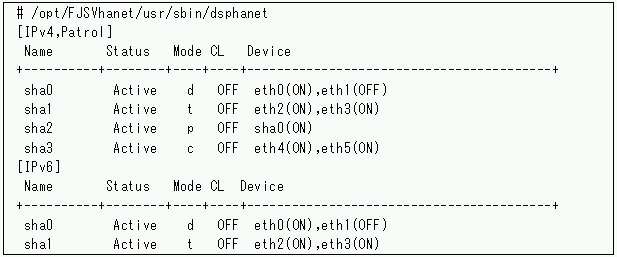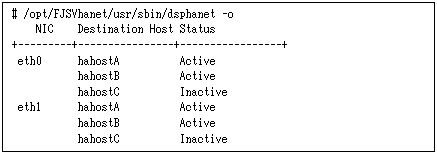[Name]
dsphanet - Displaying the operation status of virtual interfaces
[Synopsis]
/opt/FJSVhanet/usr/sbin/dsphanet [-n devicename1[,devicename2,...] | -o]
[Feature description]
The dsphanet command displays the current operation status of virtual interfaces and logical virtual interfaces.
[Option]
You can specify the following options:
Specify the name of a virtual interface whose status should be displayed. You can specify more than one virtual interface by listing them delimited with a comma (,). If this option is not specified, this command displays all the virtual interfaces that are properly defined.
Displays all communication parties of virtual interfaces defined in Fast switching mode (operation mode "t"). This option does not display communication parties of virtual interfaces not yet activated using the strhanet command.
[Display format]
The following shows the display formats used when no option is specified and when the -n option is specified.

Display | Contents | |
|---|---|---|
[IPv4,Patrol] | Virtual interface information of an IPv4 address and standby patrol form. | |
[IPv6] | Virtual interface information of an IPv6 address form. | |
Name | A virtual interface name. | |
Status | Active | The status of a virtual interface is active status. |
Inactive | The status of a virtual interface is inactive status. | |
Mode | t | Fast switching mode |
d | NIC switching mode (logical IP address takeover function) | |
e | NIC switching mode (physical IP address takeover function) | |
p | Standby patrol function (automatic fail-back if a failure occurs) | |
q | Standby patrol function (immediate automatic fail-back) | |
c | GS linkage mode | |
CL | ON | Cluster resource |
OFF | None cluster resource | |
Device | (ON) | Enabled. |
(OFF) | Disabled. | |
(STOP) | Ready for use. | |
(FAIL) | Error in one system. | |
(CUT) | Unused. | |
The following shows the display format used when the -o option is specified.

Display | Contents | |
|---|---|---|
NIC | A physical interface name. | |
Destination Host | The host name of the communication target. (If the target host does not exist, it will display "none".) | |
Status | Active | The status of the communication target is active status. |
Inactive | The status of the communication target is inactive status. | |
[Related commands]
strhanet stphanet
[Notes]
This command can be specified for any virtual interfaces.
Only one option can be specified at one time.
[Examples]
The following shows an example of displaying the active or inactive status of all virtual interfaces that are properly defined in the configuration information for Redundant Line Control Function.
# /opt/FJSVhanet/usr/sbin/dsphanet |
The following shows an example of displaying all the communication parties of virtual interfaces in Fast switching mode (operation mode "t") properly defined in the configuration information for Redundant Line Control Function.
# /opt/FJSVhanet/usr/sbin/dsphanet -o |